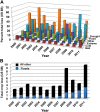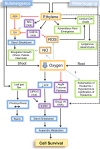Waterproofing crops: effective flooding survival strategies
- PMID: 23093359
- PMCID: PMC3510103
- DOI: 10.1104/pp.112.208173
Waterproofing crops: effective flooding survival strategies
Figures



References
-
- Abiko T, Kotula L, Shiono K, Malik AI, Colmer TD, Nakazono M. (2012) Enhanced formation of aerenchyma and induction of a barrier to radial oxygen loss in adventitious roots of Zea nicaraguensis contribute to its waterlogging tolerance as compared with maize (Zea mays ssp. mays). Plant Cell Environ 35: 1618–1630 - PubMed
-
- Angaji SA, Septiningsih EM, Mackill DJ, Ismail AM. (2010) QTLs associated with tolerance of flooding during germination in rice (Oryza sativa L.). Euphytica 172: 159–168
-
- Arshad RR, Shafi S. (2010) Pakistan Floods 2010: Preliminary Damage and Needs Assessment. Asian Development Bank and World Bank, Islamabad, Pakistan
-
- Baena-González E. (2010) Energy signaling in the regulation of gene expression during stress. Mol Plant 3: 300–313 - PubMed
Publication types
MeSH terms
Substances
LinkOut - more resources
Full Text Sources
Medical

